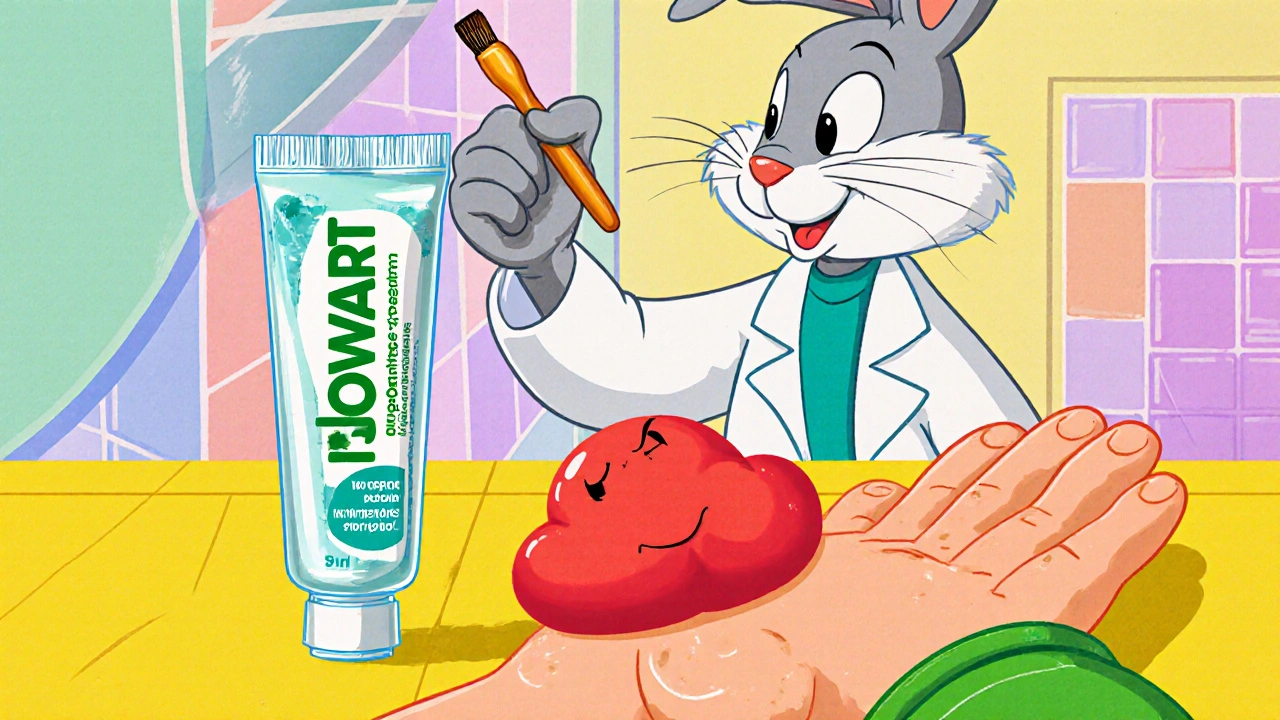
Wart Treatment Selector
Choose Your Treatment Preferences
When a stubborn wart or skin lesion refuses to fade, many turn to over‑the‑counter or prescription options. One product that keeps popping up is Podowart, a blend of Podophyllum Resin a plant‑derived compound traditionally used to treat viral skin growths, Benzoin a natural resin with soothing and antiseptic properties and Aloe Vera a gel‑rich succulent known for its moisturizing and healing effects. But is it really the best choice, or are there cheaper, safer, or more effective alternatives?
Quick Takeaways
- Podowart combines three botanicals for a multi‑action approach: antiviral, soothing, and barrier‑repair.
- Salicylic acid sticks tops the efficacy chart for common warts, while Imiquimod shines on genital warts.
- Cryotherapy delivers the fastest results but can be painful and requires a professional.
- Cost‑effective options like tea tree oil work for mild lesions but need longer treatment periods.
- Choose based on lesion type, pain tolerance, budget, and whether you prefer pharmacy‑only versus prescription routes.
What Is Podowart?
Podowart is marketed as a topical gel for treating warts, molluscum contagiosum, and other benign skin growths. The formula packs a 15% concentration of Podophyllum Resin, 10% Benzoin and 5% Aloe Vera extract. The product is sold without a prescription in many countries, making it an accessible option for self‑care.
Ingredient Deep Dive
Podophyllum Resin is derived from the root of the American mandrake plant. Its active component, podophyllotoxin, interferes with cell division, effectively halting the growth of virus‑induced lesions. Clinical studies from the early 2000s showed a 60‑70% clearance rate for common warts when applied twice daily for four weeks.
Benzoin acts as a natural fixative and antiseptic. It reduces inflammation and creates a protective film that keeps the active resin in contact with the skin. Users often report less redness compared with pure podophyllum solutions.
Aloe Vera supplies humectant properties, drawing moisture into the stratum corneum. This minimizes the cracking and irritation that can occur with harsher wart treatments. In vitro tests suggest aloe can boost skin regeneration by up to 30% when combined with antiviral agents.
How Podowart Works
The trio works on three fronts: podophyllum halts cell proliferation, benzoin keeps the formula stable and reduces irritation, and aloe soothes while promoting barrier repair. Applied twice daily, the gel should be left on the lesion for at least eight hours before washing off. Most users see visible reduction after two weeks, with full clearance by six weeks if the regimen is strict.
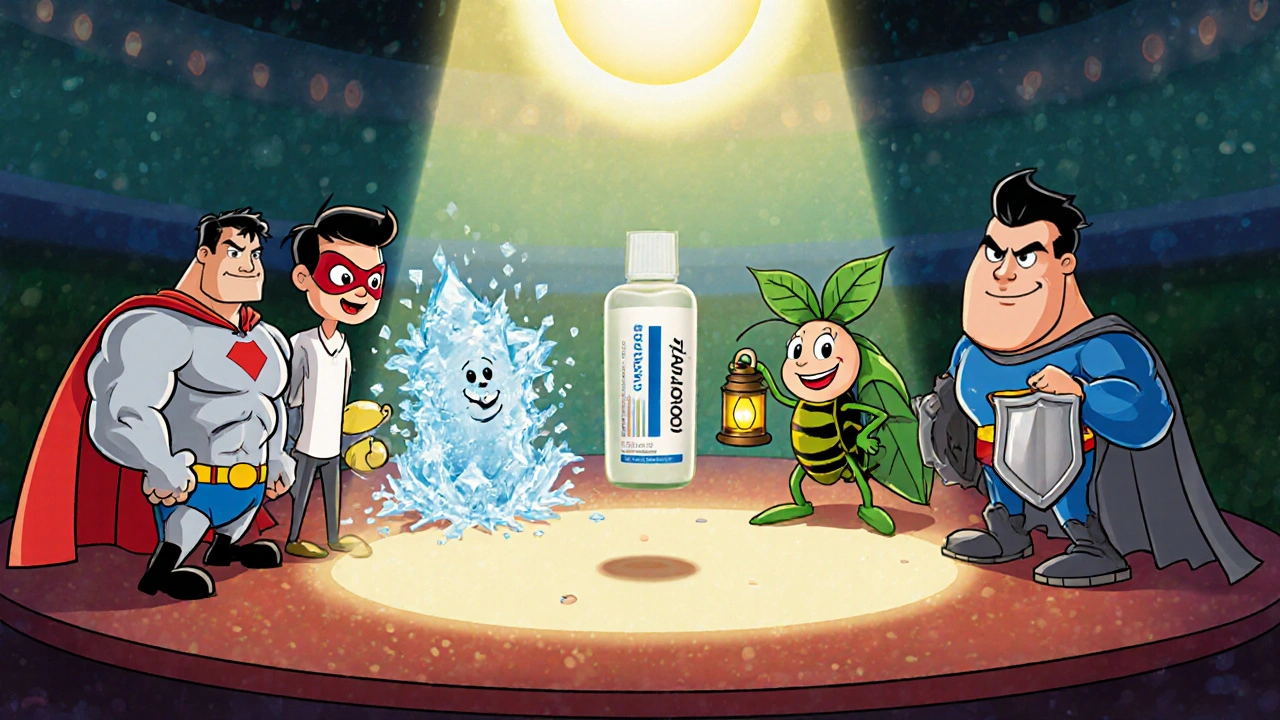
Top Alternatives to Consider
Below are the most widely used alternatives, grouped by mechanism and typical availability.
- Salicylic Acid a keratolytic acid that softens the wart’s outer layer, allowing it to peel away
- Imiquimod an immune response modifier that stimulates interferon production to fight viral lesions
- Cryotherapy freezing treatment using liquid nitrogen, usually performed by a clinician
- Cantharidin a vesicant extracted from blister beetles that causes the wart to blister and lift off
- Tea Tree Oil an essential oil with antimicrobial and mild antiviral properties, often used in home remedies
Side‑by‑Side Comparison
| Product | Active Ingredient | Typical Clearance Rate | Common Side Effects | Average Cost (AUD) | Prescription Needed? |
|---|---|---|---|---|---|
| Podowart | Podophyllum Resin (15%) + Benzoin (10%) + Aloe Vera (5%) | 65% after 6weeks | Redness, mild irritation | $25 (30g tube) | No |
| Salicylic Acid (OTC) | Salicylic Acid 17‑40% | 70% after 8weeks | Dryness, peeling, occasional pain | $12 (15g tube) | No |
| Imiquimod (Aldara) | Imiquimod 5% | 80% after 12weeks (genital warts) | Local inflammation, flu‑like symptoms | $60 (5g tube) | Yes |
| Cryotherapy | Liquid Nitrogen (-196°C) | 90% after 1‑3 sessions | Bleeding, temporary numbness | $70‑$120 per session | Yes (performed by clinician) |
| Cantharidin | Cantharidin 0.7‑1.0mg/mL | 85% after 2‑4 applications | Blistering, pain | $50 (licensed pharmacy) | Yes |
| Tea Tree Oil | Melaleuca alternifolia oil (5‑10%) | ~40% after 8weeks (mild lesions) | Contact dermatitis in sensitive skin | $8 (30mL bottle) | No |
Choosing the Right Option for You
Not every wart needs the same level of aggression. Here’s a quick decision guide:
- Common plantar or hand warts: Start with an OTC salicylic acid product. It’s inexpensive and works well for thick skin.
- Flat warts on the face: Podowart’s soothing blend may be gentler on delicate skin while still delivering decent clearance.
- Genital or extensive warts: Prescription‑only Imiquimod or clinician‑applied cryotherapy offers the highest success rates.
- Small, early‑stage lesions: A few drops of tea tree oil twice daily can shrink them without harsh chemicals.
- Patients who fear needles or freezing: Podowart or cantharidin (applied by a professional) avoid the sting of liquid nitrogen.
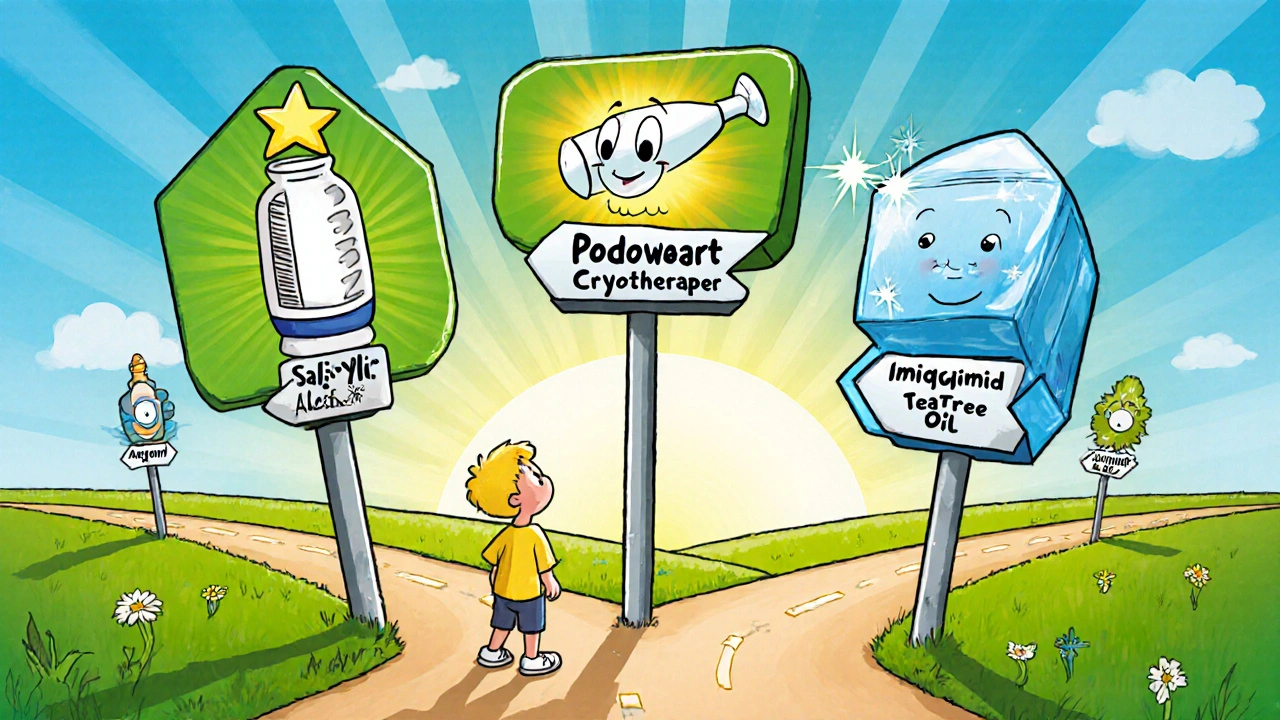
Practical Tips & Common Pitfalls
- Consistency is king: Skipping applications drops clearance rates dramatically for every product.
- Watch for irritation: If redness spreads beyond the lesion, rinse off the product and give the skin a break.
- Combine, don’t clash: Using salicylic acid and podophyllum together can cause excessive skin stripping.
- Check for contraindications: Pregnant or breastfeeding women should avoid podophyllum and cantharidin.
- Professional follow‑up: If a lesion hasn’t improved after the recommended period, see a dermatologist-persistent growth could mask a more serious condition.
FAQs
Frequently Asked Questions
Is Podowart safe for children?
Podowart is generally safe for kids over six years old, but you should do a patch test first. If the skin becomes very red or painful, stop using it and consult a pediatrician.
How long does treatment with Podowart take?
Most users see a noticeable reduction after two weeks, with full clearance in six to eight weeks if the gel is applied twice daily.
Can I use Podowart together with salicylic acid?
It’s not recommended. Both ingredients are strong keratolytics and can cause excessive irritation when combined.
What’s the biggest advantage of Cryotherapy over Podowart?
Cryotherapy works fastest-many warts disappear after a single freeze. The downside is the need for a clinician and possible discomfort.
Is tea tree oil effective for stubborn warts?
Tea tree oil can help with very early or mild lesions, but its clearance rate is lower than medically‑approved options. It’s best used when you prefer a natural, low‑cost approach.
Whether you pick Podowart, a salicylic acid kit, or a clinician‑administered treatment, the key is to match the product to the lesion type, your pain tolerance, and your budget. Keep track of progress, stay consistent, and don’t hesitate to get professional advice if a wart resists all attempts.
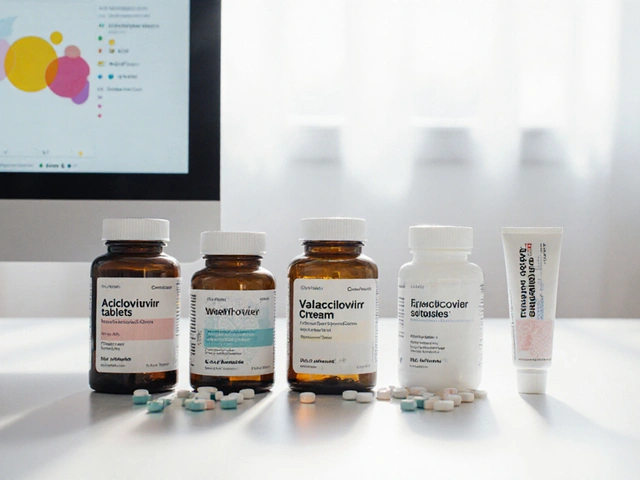



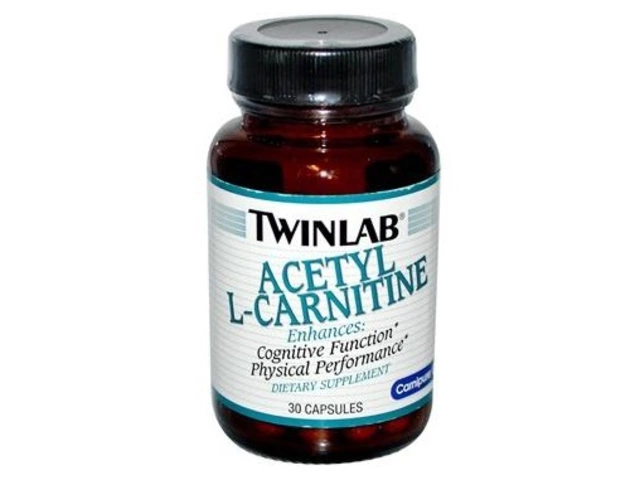
Oliver Harvey
October 15, 2025 AT 13:29Looks like the marketing team decided “more botanical buzzwords = more sales” – brilliant strategy 🙃. The resin‑plus‑gel combo is marketed like a miracle, yet the data you cited still shows a modest 65% clearance. If you’re paying $25 for a tube, you might want a clearer risk‑vs‑reward breakdown. Still, kudos for gathering the facts 😏.
Ben Poulson
October 21, 2025 AT 19:29Esteemed members of the community, I wish to express my sincere appreciation for the comprehensive comparative analysis presented herein. Your methodical juxtaposition of efficacy, cost, and accessibility is most commendable. It is evident that the author has devoted considerable scholarly effort to synthesise peer‑reviewed data. May I suggest further elaboration on the pharmacokinetics of podophyllotoxin for forthcoming editions.
Anna Graf
October 28, 2025 AT 01:29Warts are like unwanted guests that overstay their welcome. Sometimes a gentle approach works best, other times you need to be firm. The Podowart blend feels like a calm negotiator, while salicylic acid is the tough bouncer. Choose the method that matches the stubbornness of the lesion, and your skin will thank you.
Lindy Fujimoto
November 3, 2025 AT 07:29Oh dear, the drama of a stubborn wart is simply *exquisite* 😱✨! One must treat such a foe with the elegance of a ballroom dancer and the ferocity of a thunderstorm. Podowart, with its botanical trio, is practically a symphony of skin‑soothing sonatas 🎶. Yet, beware the cheap imitators that promise miracles with a wink and a smile 😉💅.